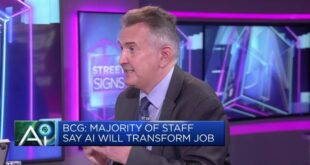A view outside Bellevue hospital during the coronavirus pandemic on May 1, 2020 in New York City.
Noam Galai | Getty Images
As hospitals, physician practices and dental offices have reopened for non-emergency care over the last month, it seems a good bet that health-care workers furloughed during March and April will be among those most likely to be recalled by their employers, but the May jobs numbers on Friday may not show much of a snap-back.
“We expect the education and health services industries to recover quicker than will the overall labor market this year,” analysts at Moody’s Investors Services wrote in research note Wednesday, adding “next year, these industries will likely add about 370,000 jobs, or 11% of total private-sector jobs created.”
While private employers added 166,000 education jobs last month, according to payroll processing firm ADP’s May employment report, it was a different story in health care. The private sector shed another 333,000 health care jobs in May, bringing losses over the last three-months to more than 2.4 million.
Dental jobs could see May bounce
Dentistry saw the biggest employment losses in the health care sector care in April, shedding more than 500,000 jobs, but preliminary data from the American Dental Association show the dental sector could see a healthy bounce back in the May jobs report.
By last week, 90% of dental practices had reopened, up from 65% in mid-May. More than three out of four practices report paying their staff fully, with patient volumes at about 52% of pre-Covid levels by the end of the month.
“All of all of my predictions are turning out to be overly bearish. I’d expected a slower recovery and slower rebound in patient volume, and slower bounce back in hiring,” said Marko Vujicic ADA chief economist and vice president.
Slower recovery
The vast majority of physician practices had reopened by the end of last month, as states lifted the moratorium on non-emergency care, but doctors continue to feel the financial strain of the pandemic shutdown. Some 95% of practices have resumed seeing patients in the office, but about half of primary care doctors surveyed by the Larry A. Green Center last week said that the volume of visits remained down more than 50% from pre-Covid levels.
Nearly 28% of mostly small practices surveyed had skipped or deferred clinician salaries by month’s end, while more than 35% of practices had laid off or furloughed staff. Just over one-in-five said that bills for telehealth visits had been denied. The full results of the survey will be published Friday.
“I think it’s going to be a hard and slow recovery … those who close due to lack of payment may not be able to return. I think what we are seeing is a permanent shrinking of the primary care platform,” said Rebecca Etz, associate professor of family medicine at Virginia Commonwealth University and co-director of the Larry A Green Center.
The situation is not much better for physician practices that fall under a hospital system.
“The 60% employed by hospitals and health systems are likely to be vulnerable to prolonged hiring freezes,” said Etz, noting that 11% of physician practices reported that they had rescinded job offers to incoming medical residents.
Hospitals slow to rehire
In April, the hospital sector cut nearly 135,000 jobs, as patient volumes and medical care revenues plunged during the national Covid shelter-in-place order, and health care facilities across the country postponed virtually all non-emergency procedures.
Over the last month, health systems have seen a rebound in demand for rescheduling postponed elective surgical procedures, but overall volumes have remained well below pre-March levels.
Through mid-May in-patient volumes were down about 20%, but emergency department visits were still down 40% from late February, according to research from health care division of financial payments firm TransUnion.
Hospitals around the country have ramped up advertising and community outreach to assure people it’s safe to come back to their facilities, but they continue to see patients putting off care. At the same time, new social distancing and coronavirus disinfecting procedures will also hamper their ability to handle patient volumes at pre-Covid levels.

“The ones we talk to are being extremely mindful of not jumping the gun in terms of necessarily bringing everybody back immediately,” said James Bohnsack, chief strategy officer of TransUnion Healthcare. “They’re having to be mindful and kind of rethink their strategies around expenses overall, which is mostly driven, as you can imagine by the staffing.”
Top of mind for many hospital executives is that the recovery in patient volumes over the summer could be short-lived. Most executives anticipate a significant second wave of coronavirus later this year, according to research from consulting firm LEK, and two-thirds of hospital leaders expect that they will have to cut back on non-Covid care once again when that wave hits next winter.
 EU News Digest Latest News & Updates
EU News Digest Latest News & Updates



